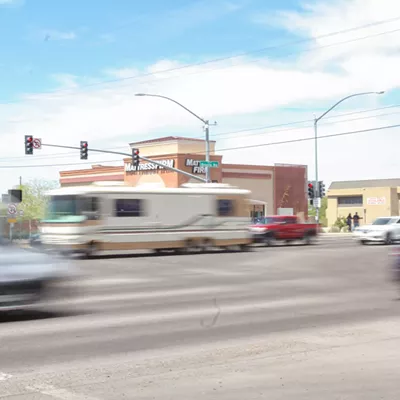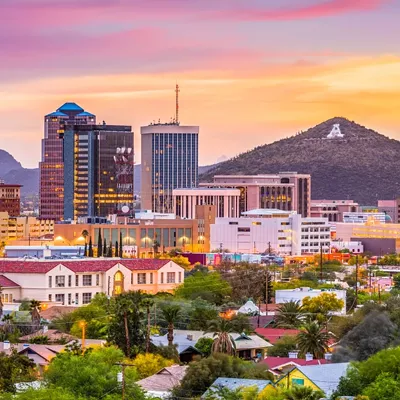Carbon Monoxide
Measured at six monitoring sites in the metropolitan Tucson area, carbon monoxide levels have decreased steadily over the last 10 years. Experts attribute cleaner-burning vehicle improvements and Arizona's vehicle-emissions tests for the carbon monoxide decrease. The pollutant now rarely peaks at much more than half the federal Environmental Protection Agency standard. Predictions, however, are that carbon monoxide levels will increase again as growth overwhelms the effects of vehicle-emissions controls.
Ozone
Ground-level ozone is not as closely associated with car and truck exhausts as carbon monoxide but they still account for more than half its precursors. Significant contributors include factories and construction sites where large volumes of volatile organic chemicals are used. High temperatures and intense sunlight spur chemical reactions that produce ozone, an unusual and unhealthy oxygen molecule.
Measured at five sites around Tucson, summer time levels of ozone frequently come close to exceeding federal standards. It fact, they apparently exceeded them at sites on the southeast side in 1997 and in 1998.
The American Lung Association, however, does not believe the federal EPA standard adequately protects public health and issues warnings when its lower ozone standard is exceeded. The association reports their standard was exceeded twice in the metropolitan area in 1999.
To determine more detailed ozone levels throughout the community, for the past four years the Pima Association of Governments (PAG) has worked with a University of Arizona consultant on a computer model called SMOGMAP. PAG soon should be able to use this model to help policy makers with cost-benefit decisions on corrective measures if the federal ozone standard eventually is violated. According to PAG these measures could include, "a more rigorous vehicle emissions inspection program ... one of several varieties of reformulated gasolines, and -- recovery of gasoline fumes during the refueling process," requiring a flexible hood over gasoline and diesel hose nozzles.
Particulates
Wayne Byrd, program manager for the Pima County Department of Environmental Quality, says particulates in the air are the greatest concern of physicians and government regulators and are increasing as the Tucson area grows.
Particulates, scientists' name for tiny particles that penetrate the human lung's natural defenses, are measured for 10 micron in size material [PM-10] at eight monitoring stations and for 2.5 microns [PM-2.5] at two locations. Traffic generates most of the larger particulates. The smaller particles come from a variety of sources including traffic, diesel fumes, and the Arizona Portland Cement plant in Rillito, on the northwest side.
The federal PM-10 standard was exceeded several times in 1999 but that was not repeated last year. The federal government considers northwest Tucson, however, a violation area for PM-10 particulates.
Because of the 1999 events, local air quality officials have been preparing a report for EPA that is due this summer. It will suggest a number of non-driving-related corrective measures which could include dust suppressants such as more watering of construction sites, the reduction or cessation of construction activities during periods of high winds, and limiting the area of bare earth bladed on a construction site.
Local levels of the smaller PM-2.5 particles have remained relatively constant for several years at the only two monitoring sites and are about two-thirds of the federal standards. The health impacts of these very tiny particulates are of great concern to doctors, researchers and air-quality planners.
Visibility
According to a 1999 Arizona Department of Environmental Quality report, visibility has not changed substantially in Tucson over the last several years. Earlier studies indicated otherwise. Numerous attempts during a four-week period to obtain more data on visibility from Environmental Quality were unsuccessful.
Pollen
Since the 1940s there has been an explosion of pollen in Tucson's air. The planting of olive and mulberry trees has been outlawed for more than a decade now, but pollen-producing vegetation such as grasses, pine, sumac, juniper and cypress have continued to increase as Tucson has grown.
Odors
Odors from manufacturing plants, sewage treatment facilities, paint shops and other sources also are related to population growth. Ten years ago Pima County received 160 complaints about odors, in 1995 there were 238, and last year 174. Fifty-six of the most recent complaints came from Marana and the booming northwest side with another 47 from the central part of the community. The southside reported 28 of the complaints, the foothills 15, and the remainder were from around the metropolitan area.










